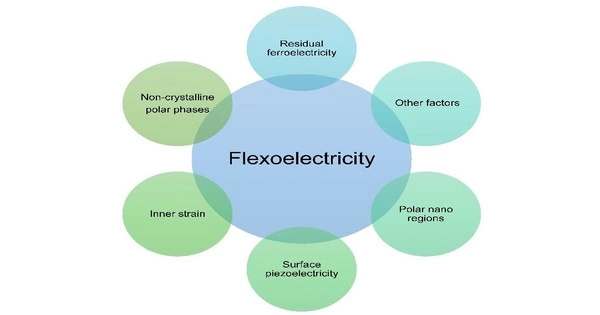Flexoelectricity is a dielectric material property in which it exhibits spontaneous electrical polarization caused by a strain gradient. It refers to the ability of a material to generate an electric field when it undergoes deformation or strain gradients, known as flexural or bending deformations. Unlike piezoelectricity, which generates an electric field in response to applied mechanical stress, flexoelectricity arises from variations in the material’s strain gradient, which can be caused by a wide range of mechanical deformations.
Flexoelectricity is a relatively new field of study, with significant potential for a variety of applications, including sensors, actuators, and energy harvesting. It has been observed in a range of materials, including ferroelectrics, semiconductors, and even biological membranes.
Flexoelectricity is closely related to piezoelectricity, but where piezoelectricity refers to polarization due to uniform strain, flexoelectricity refers to polarization due to strain that varies from point to point in the material. This nonuniform strain disrupts centrosymmetry, which means that, unlike piezoelectricity, flexoelectric effects can occur in centrosymmetric crystal structures.
The flexoelectric effect is dependent on the gradient of strain or deformation, which can be very small and difficult to measure accurately. However, advances in experimental techniques and theoretical models have led to significant progress in understanding the underlying physics of flexoelectricity and its potential applications in various fields.
Flexoelectricity is not the same as ferroelasticity. Inverse flexoelectricity is defined as the generation of a strain gradient as a result of polarization. Similarly, converse flexoelectricity refers to the process by which a polarization gradient induces strain in a material.
Due to the flexoelectric effect, a large inhomogeneous deformation in dielectric materials can break or significantly alter the material’s inversion symmetry, resulting in net polarization. This phenomenon differs from other types of electromechanical coupling, such as piezoelectricity and electrostriction, in that it is an intrinsic and universal effect whose strength increases as the sample size decreases.
Application
Flexoelectricity has a wide range of potential applications, including in sensors, actuators, and energy harvesting devices. It has been studied in a variety of materials, including ceramics, polymers, and biological materials. However, the effect is generally small and requires careful optimization of the material properties and device design to achieve useful levels of performance.
















